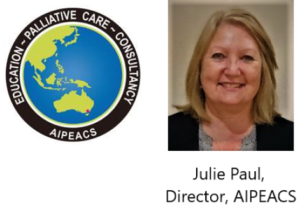
JULIE’S UPDATE: JUNE 2025
今月は、引き続きコミュニケーションに焦点を当てていきたいと思います。以前、私が素晴らしいオーストラリアの資料として紹介した、
「進行期のがん患者とその介護者に対する予後と終末期の問題に関する臨床実践ガイドライン」というタイトルの資料について、(このリンクからダウンロード可能です:https://www.mja.com.au/journal/2007/186/12/clinical-practice-guidelines-communicating-prognosis-and-end-life-issues-adults)
このガイドラインでは、「余命と終末期に関するコミュニケーションは、進行期の余命が制限された疾患の患者とその家族をケアする医療従事者にとって不可欠なスキルである」と明記されています。(https://www.mja.com.au/journal/2007/186/12/clinical-practice-guidelines-communicating-prognosis-and-end-life-issues-adults 2025年6月30日にアクセス)
このガイドラインは2007年に作成されましたが、私の見解では、現在の臨床実践においても依然として非常に関連性があります。
ガイドラインは、以下の重要性を再確認させてくれます:
- ・予後と終末期に関する対話のタイミング
- ・対話の準備
- ・物理的・社会的環境の調整
- ・予後と終末期に関する問題をどう対話するか?
- ・予後と終末期の問題を対話する際、希望と対処を促進するための一般的な戦略、および自己ケアの役割(医療従事者向け)
- 要約ページは優れたリソースであり、この本の推奨事項を臨床実践で考慮する際の指針として「PREPARED」という略語を提案しています。
- 例えば:
- P = 可能な限り、対話に備える
- R = 患者とつながる
- E = 患者と介護者の好みを引き出す
- P = 患者と家族の個々のニーズに合わせた情報を提供する
- A = 感情と懸念を認める
- R = 現実的な希望を育む
- E = 質問とさらなる対話を促す
- D = 記録し、会話と合意された結果がチーム全体に共有されるようにする
- 「PREPARED」の略語の詳細を理解するために、要約文書を読むことをお勧めします。
- このガイドラインに関するご意見や、臨床実践の向上や患者・家族とのコミュニケーション改善に活用できる新たな情報を学んだかどうかについて、お聞かせいただければ幸いです。
- 以下の2つの記事が参考になるかもしれません:
- ・「切除不能または再発がんを有する日本人患者における緩和ケアと健康状態に関するコミュニケーションの理解:横断的調査」(2021年)Hiratsuka Y, Oishi T, Miyashita M, Morita T, Mack JW, Takahashi M, Shirota H, Otsuka K, Ishioka C, Inour A https://apm.amegroups.org/article/view/62393/html、
- ・終末期がん患者の緩和医療医とのコミュニケーションと行動:東アジア3カ国における調査、2021年、Takashi Yamaguchi, Isseki Maeda, Yutaka Hatano, Sang Yeon Suh, Shao Yi Cheng, Sun Hyun Kim, Ping Jen Chen, Tatsuya Morita, Satoru Tsuneto, Masanori Mori https://www.sciencedirect.com/science/article/pii/S0885392420306382
- この分野に関する追加のリソースにご興味がある場合は、お気軽に連絡ください。ご要望に応じてお送りいたします。 緩和ケアに関するご意見やご経験を共有していただけると幸いです。そうすることで、互いに学び合えるからです。
- 安全にお過ごしください。
- Julie
- ジュリー・ポール – OAM
-
-
Disclaimer: JUNE 2025 免責条項:
Julie’s Update シリーズ内の内容につき正確な情報の提供に細心の注意を注いでいますが、特にある事柄についての専門的意見を提供するものではありません。このシリーズに含まれる情報は、独立した専門家の見解に取って代るものではありません。また、医療上の助言として利用したり、何らかの疾患の治療、手当、又は、予防のために使用されるものではありません。
このシリーズにより提供される情報の利用、依存によるいかなる法的責任、怪我、紛失、損害については、責任は負いません 。
-
Julie’s Update: JUNE2025(原文) -
-
This month I would like to continue our focus on communication.Some time ago now I introduced you to what I feel is a great Australian resource titled,
-
“Clinical practice guidelines for communicating prognosis and end of life issues with adults in the advanced stages of a life limiting illness and their caregivers”. (it can be downloaded using this link https://www.mja.com.au/journal/2007/186/12/clinical-practice-guidelines-communicating-prognosis-and-end-life-issues-adults).
The guideline confirms “Prognosis and end of life communication are a vital skill for health care professionals caring for patients with progressive life limiting illnesses and their families”. (https://www.mja.com.au/journal/2007/186/12/clinical-practice-guidelines-communicating-prognosis-and-end-life-issues-adults accessed 30/6/2025).
Whilst this guideline was developed in 2007, from my perspective it is still very relevant to today’s clinical practice.
The guideline reminds us of the importance of:
- ・Timing of prognostic and end of life discussions
- ・Preparation for the discussion
- ・Physical and social setting
- ・How to discuss prognosis and end of life issues?
- ・General strategies to facilitate hope and coping when discussing prognosis and end of life issues, and
- ・Role of self-care (for health care workers)
The summary page is a great resource and suggests the acronym of “PREPARED” as a reminder of what we need to do in considering the recommendations within this book, in our clinical practice. For example:
- P = Ensuring we are prepared for the discussion where possible
- R = Relate to the person
- E = Elicit patient and caregiver preferences
- P = Provide information tailored to the individual needs of both the patient and their families
- A = Acknowledge emotions and concerns
- R = (foster) Realistic hope
- E = Encourage questions and further discussions
- D = Document, ensure the conversation and agreed outcomes is known by the whole team
I would encourage you to read the summary document to understand the detail within the acronym of “PREPARED”.
I am very interested in your thoughts on this guideline and whether there was any new information you learnt that you can use to enhance your clinical practice, and improve communication with patients and families.
-
Here are two articles you may be interested in:
- ・Patients Understanding of Communication about Palliative Care and Health Condition in Japanese Patients with Unresectable or Recurrent Cancer, a Cross Sectional Survey, (2021), Hiratsuka Y, Oishi T, Miyashita M, Morita T, Mack JW, Takahashi M, Shirota H, Otsuka K, Ishioka C, Inour A https://apm.amegroups.org/article/view/62393/html
- ・Communication and Behaviour of Palliative Care Physicians of Patients with Cancer Near End of Life in Three East Asian Countries, 2021, https://www.sciencedirect.com/science/article/pii/S0885392420306382, Takashi Yamaguchi, Isseki Maeda, Yutaka Hatano, Sang Yeon Suh, Shao Yi Cheng, Sun Hyun Kim, Ping Jen Chen, Tatsuya Morita, Satoru Tsuneto, Masanori Mori
-
As always if you are interested in more resources in this area, please let me know and I can forward them through to you. Please let me know how you are going, as we enjoy sharing your thoughts and experiences on palliative care, so we can continue to learn from each other.
Stay safe and take care.
Julie
Julie Paul – OAM
-
-
